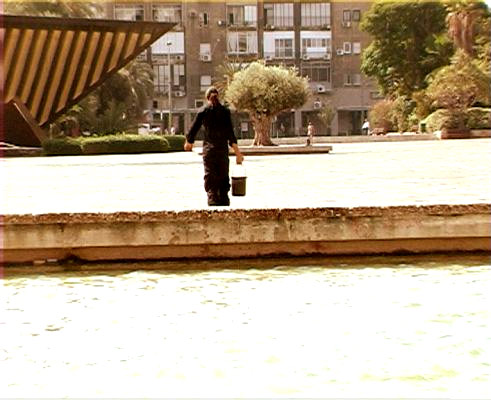

Video, 3 min 50 sec
Se svolením autora / courtesy the artist
Tak jako u mnohých dalších děl palestinských umělců, i zde jsou všechny části
videa plné symbolů. Olivovník, o který umělec pečuje, je lyrickou a přitom silnou připomínkou vesnického života před okupací, je znamením ztraceného ráje
a palestinské identity obecně. Důležitá je také hudba. „Opouštím toto místo” zpívá se v písni libanonského zpěváka Ahmada Kaaboura, nazvané Hob (Láska) z roku 1976. Evokuje exodus Palestinců a sen o „právu na návrat” a vyjadřuje potřebu palestinské solidarity. Když kamera zabere strom v širším úhlu, vidíme, že je vlastně vysazen v srdci Tel Avivu, na Rabinově náměstí, které je spojeno s politickými demostracemi, oslavami izraelského Dne nezávislosti a atentátem na premiérského předsedu Yitzahaka Rabina. Strom je sice vysazen v palestinské půdě, vypadá ale izolováně a cize, obklopen betonem.
Like with many works by Palestinian artists, all parts of this video are charged with symbolic quality. The olive tree that the artist lovingly cares for functions as a lyrical yet powerful sign the rural life before the occupation, the sign of the Lost Paradise, and the Palestinian identity in general. The music is also essential. "I leave the place" goes the refrain of the Lebanese singer Ahmad Kaabour's song Hob (Love) of 1976, evoking the exodus of Palestinians and the dream of "the right of return", and expressing the need for Palestinian solidarity. As the camera zooms out we find out that the olive tree is actually planted at the heart of the concourse of Tel Aviv's Rabin Square identified with political demonstrations, celebrations of Israel's Independence Day, and the assassination of Prime Minister Yitzhak Rabin. The tree is indeed planted on the land of Palestine, but it looks isolated and foreign surrounded by concrete.